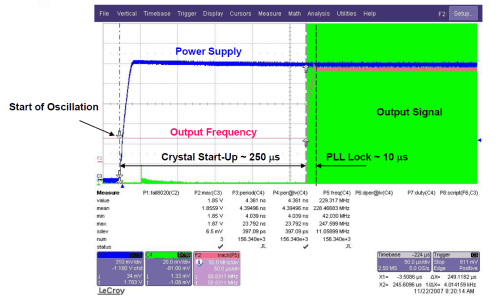JAJSNG3D June 2013 – February 2024 CDCE913-Q1 , CDCEL913-Q1
PRODUCTION DATA
- 1
- 1 特長
- 2 アプリケーション
- 3 概要
- 4 Device Comparison
- 5 Pin Configuration and Functions
- 6 Specifications
- 7 Parameter Measurement Information
- 8 Detailed Description
- 9 Application and Implementation
- 10Register Maps
- 11デバイスおよびドキュメントのサポート
- 12Revision History
- 13Mechanical, Packaging, and Orderable Information
パッケージ・オプション
メカニカル・データ(パッケージ|ピン)
- PW|14
サーマルパッド・メカニカル・データ
- PW|14
発注情報
9.2.2.3 Crystal Oscillator Start-Up
When the CDCE913-Q1 or CDCEL913-Q1 device is used as a crystal buffer, crystal oscillator start-up dominates the start-up time compared to the internal PLL lock time. Figure 9-5 shows the oscillator start-up sequence for a 27-MHz crystal input with an 8-pF load. The start-up time for the crystal is on the order of approximately 250 µs, compared to approximately 10 µs of lock time. In general, lock time is an order of magnitude less than the crystal start-up time.
 Figure 9-5 Crystal Oscillator Start-Up vs. PLL Lock Time
Figure 9-5 Crystal Oscillator Start-Up vs. PLL Lock Time